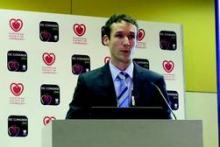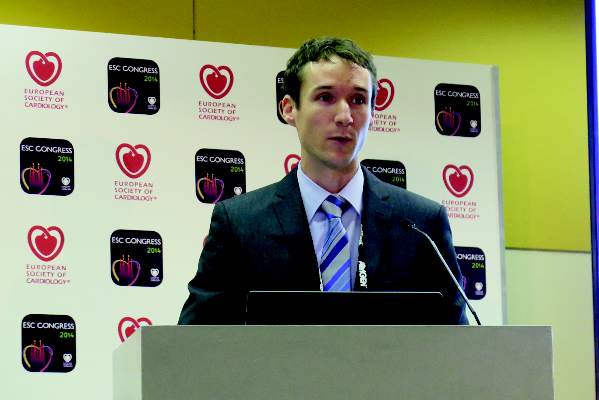User login
BARCELONA – Swiss researchers have modified an automatic wristwatch, attached it to a pig’s heart, and successfully harvested more than enough energy from this constantly beating muscle to create the first batteryless pacemaker of its kind.
The feasibility study was presented at the annual congress of the European Society of Cardiology, and Dr. Sylvia G. Priori of NYU Langone Medical Center, New York, said that it “could revolutionize how the devices are made.”
Batteries take up almost half of the space in today’s pacemakers, said Adrian Zurbuchen, an engineer at the University of Bern, Switzerland, who presented the study. In addition, they have to be replaced, which increases costs and the risk of complications.
Meanwhile, automatic watches, which have a history trailing back to the 18th century, have proven effective in harvesting the power of motion to keep the clock running. So what happens if this motion comes from the beating heart to power a pacemaker?
To find the answer, the research team modified a commercially available automatic wristwatch, and after performing a sternotomy in domestic pigs, they sutured it to the myocardium on the anteroapical part of the left ventricle.
The system includes an electric circuit that transforms the energy and powers a custom-made pacemaker, and epicardial leads that deliver the electrical stimuli to the heart.
The group successfully tested the system in vivo and performed batteryless pacing at 130 beats per minute, Mr. Zurbuchen reported. The device generated a mean output power of 52 microwatts, which is nearly five times more than the power required by a modern pacemaker, he said.
Researchers are now looking into less invasive ways of implanting the device, which has not been commercialized.
Dr. Priori and Mr. Zurbuchen had no disclosures.
On Twitter @naseemmiller
BARCELONA – Swiss researchers have modified an automatic wristwatch, attached it to a pig’s heart, and successfully harvested more than enough energy from this constantly beating muscle to create the first batteryless pacemaker of its kind.
The feasibility study was presented at the annual congress of the European Society of Cardiology, and Dr. Sylvia G. Priori of NYU Langone Medical Center, New York, said that it “could revolutionize how the devices are made.”
Batteries take up almost half of the space in today’s pacemakers, said Adrian Zurbuchen, an engineer at the University of Bern, Switzerland, who presented the study. In addition, they have to be replaced, which increases costs and the risk of complications.
Meanwhile, automatic watches, which have a history trailing back to the 18th century, have proven effective in harvesting the power of motion to keep the clock running. So what happens if this motion comes from the beating heart to power a pacemaker?
To find the answer, the research team modified a commercially available automatic wristwatch, and after performing a sternotomy in domestic pigs, they sutured it to the myocardium on the anteroapical part of the left ventricle.
The system includes an electric circuit that transforms the energy and powers a custom-made pacemaker, and epicardial leads that deliver the electrical stimuli to the heart.
The group successfully tested the system in vivo and performed batteryless pacing at 130 beats per minute, Mr. Zurbuchen reported. The device generated a mean output power of 52 microwatts, which is nearly five times more than the power required by a modern pacemaker, he said.
Researchers are now looking into less invasive ways of implanting the device, which has not been commercialized.
Dr. Priori and Mr. Zurbuchen had no disclosures.
On Twitter @naseemmiller
BARCELONA – Swiss researchers have modified an automatic wristwatch, attached it to a pig’s heart, and successfully harvested more than enough energy from this constantly beating muscle to create the first batteryless pacemaker of its kind.
The feasibility study was presented at the annual congress of the European Society of Cardiology, and Dr. Sylvia G. Priori of NYU Langone Medical Center, New York, said that it “could revolutionize how the devices are made.”
Batteries take up almost half of the space in today’s pacemakers, said Adrian Zurbuchen, an engineer at the University of Bern, Switzerland, who presented the study. In addition, they have to be replaced, which increases costs and the risk of complications.
Meanwhile, automatic watches, which have a history trailing back to the 18th century, have proven effective in harvesting the power of motion to keep the clock running. So what happens if this motion comes from the beating heart to power a pacemaker?
To find the answer, the research team modified a commercially available automatic wristwatch, and after performing a sternotomy in domestic pigs, they sutured it to the myocardium on the anteroapical part of the left ventricle.
The system includes an electric circuit that transforms the energy and powers a custom-made pacemaker, and epicardial leads that deliver the electrical stimuli to the heart.
The group successfully tested the system in vivo and performed batteryless pacing at 130 beats per minute, Mr. Zurbuchen reported. The device generated a mean output power of 52 microwatts, which is nearly five times more than the power required by a modern pacemaker, he said.
Researchers are now looking into less invasive ways of implanting the device, which has not been commercialized.
Dr. Priori and Mr. Zurbuchen had no disclosures.
On Twitter @naseemmiller
AT THE ESC CONGRESS 2014
Key clinical point: The heartbeat can be harvested to power a medical device such as a pacemaker.
Major finding: A modified automatic wristwatch successfully powered a batteryless pacemaker in pigs.
Data source: In vivo study in pigs.
Disclosures: Dr. Priori and Mr. Zurbuchen had no disclosures.

